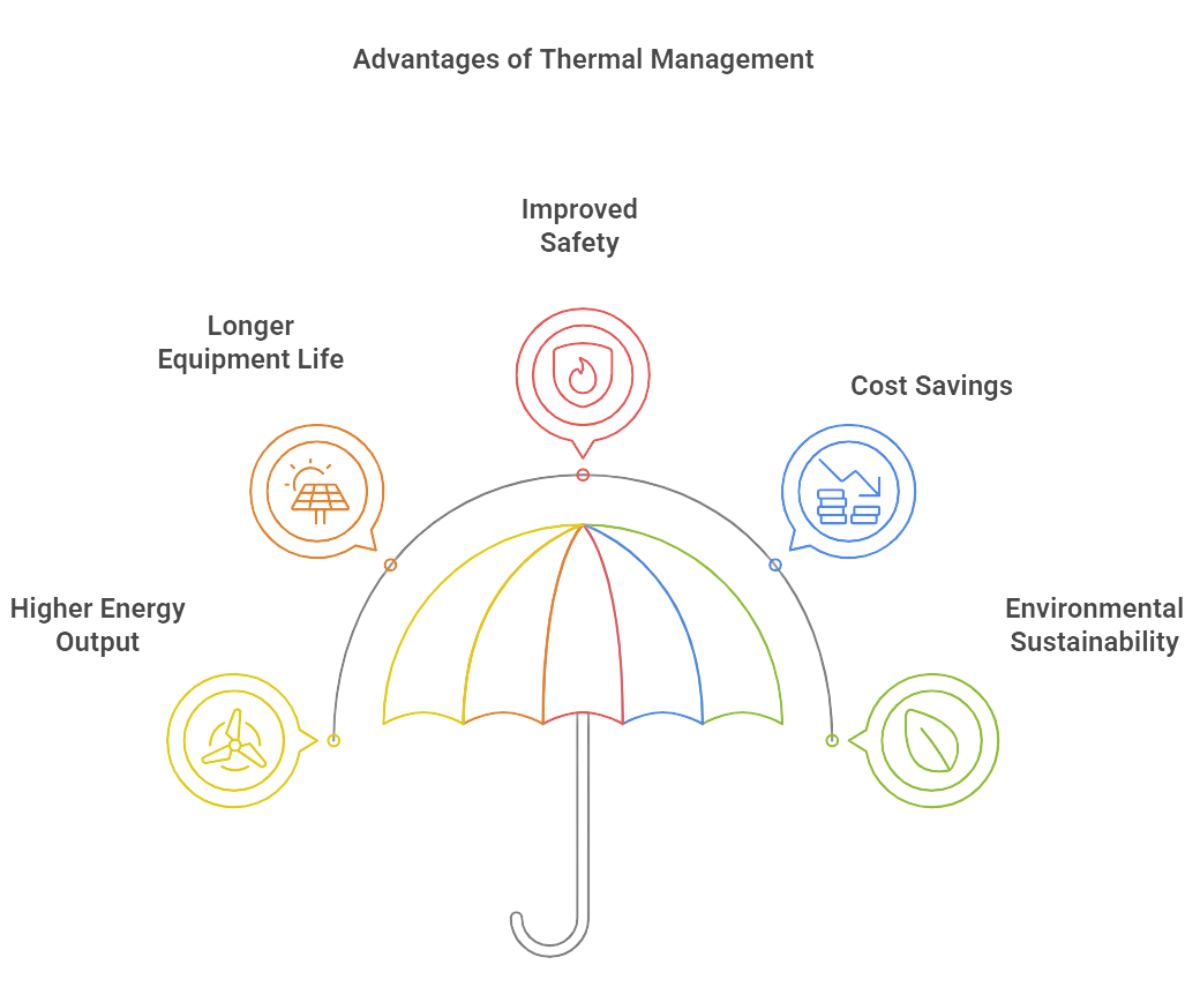As the global community shifts towards using renewable power sources such as solar and wind, one major challenge is the heat associated with these systems. What is fascinating is that concepts of EV thermal management are now being adopted to boost the implementation of renewable energy systems.
Effects Of Heat Management On Renewable Energy Systems Performance
Renewable energy systems, including solar panels, wind turbines, and battery storage, generate heat. Not addressing such heat can lead to the following problems:
- Reduced energy Efficiency: Overheating components, such as inverters or batteries, cause them to not operate at their best, which leads to energy loss.
- Safety Risks: Out-of-control heating can lead to more serious events, such as fires or system failure.
These systems are often kept within a safe thermal range to enhance reliability. Heat is such a crucial determinant of efficiency.
How does Thermal Management aid in the Efficiency of Renewable Energy Systems
Energy Conversion Improvement
-
- Overheating solar panels would worsen electricity generation. With proper thermal management, these panels can be kept optimally cooled, maximizing energy output
- Wind turbines control heat generated within the gearbox or generator to increase energy conversion efficiency.
Battery Storage Improvement
-
- Extra energy caused by solar panels or wind turbines can easily be stored using battery storage devices.
- With EV thermal management, batteries can be maintained at the ideal temperature, leading to an improved charge/discharge rate and extended lifespan. These are just a few advantages.
Consistent Performance in Extreme Weather
- Several renewable energy systems such as deserts or icy regions, can never function in extreme temperatures.
- Essential thermal control will ensure these systems work consistently in these temperature scenarios.
Reduced Energy Loss
- One of the most prominent inefficiencies of renewable power systems is heat loss.
- Advanced methods of thermal management control this issue by capturing more energy than the systems lose.
Thermal Management of Renewable Energy Systems
There are many methods of cooling and managing heat that can improve the operation of renewable energy systems. These are
Air Cooling Systems
- Solar panels, inverters, and batteries lose a lot of heat, and fans and ventilation systems are the best ways to combat that heat.
- Although this might not collect heat effectively. It’s beneficial for its budget-friendly and simpler design.
Phase Change Materials (PCMs)
- These materials will melt to liquid when they’re exposed to heat.
- Passive cooling components are used in these materials in both renewable energy and EV thermal management systems.
Heat Pumps
- These systems can be set to cool or heat components, making them multi-use systems. They are especially suited for renewable energy systems where ambient conditions change.
Advanced Materials
- These include graphene or aluminum, as they possess increased thermal conductivity, improving the heat transfer rate.
- These materials are deployed in the solar panels and battery packs to improve thermal management.
Benefits of Thermal Management for Renewable Energy Systems

- Higher Energy Output: Effective thermal management enables renewable systems to operate at better efficiency rates and generate energy with much less renewables at much less loss.
- Longer Equipment Life: Lesser maintenance is needed, and damage to components is restricted, resulting in a much longer life for their solar panels, wind turbines, and batteries.
- Improved Safety: Thermal control helps to eliminate risks associated with overheating systems like fires and faltering machinery.
- Cost Savings: Efficient thermal management helps control the energy lost thermally during the processes, hence saving money in the long run.
- Environmental Sustainability: Having the systems operate more efficiently and produce less waste causes them to be more sustainable, allowing thermal management to aid the renewable energy systems in being more sustainable.
Challenges in Thermal Management for Renewable Energy
Before we move forward, mentioning the challenges associated with thermal management is imperative. Those are as follows
- High Expenditure: Advanced cooling solutions like PCMs or liquid cooling systems could significantly increase the initial costs of installing renewable energy projects.
- Complexity of Integration: Thermal management systems can be challenging to incorporate into existing or more compact setups.
- Consumption of Fuel/Energy: These active cooling systems require a certain degree of energy to function, impairing the system’s overall effectiveness.
Renewable Energy Thermal Management- A Glimpse into the Future
Systems with Artificial Intelligence
-
- AI has a big part to play. It can track and regulate the thermal management systems to reach their objectives in real-time.
- Once again, think of it as EV thermal management. AI systems will understand the patterns of heat generation and only then switch on the cooling systems, thereby increasing efficiency.
Liquid Passive Hybrid Cooling Solutions
-
- Efficiencies and cost-effectiveness can be blended by integrating liquid cooling with passive options such as PCMs.
Materials that are Sustainable and Recyclable
-
- In the future thermal management systems, we will have to use materials with the lowest environmental impacts, fitting in with the ethos of renewable energy sustainability.
Integrated Designs
-
- Bolstered cooling components may be incorporated into inverters and batteries, reducing the need for cooling installation and the entire system’s complexity.
Recovery of Waste Heat
-
- More sophisticated systems can harness the wasted heat developed from renewable energy sources and use it for other applications, such as warming buildings or feeding into turbines for additional power generation.
Conclusion
Heat management is one crucial aspect of improving the productivity, security and durability of renewable energy systems. Renewable energy technologies can adopt advanced liquid cooling methods, phase-change materials, and AI control systems, drawing parallels to EV thermal management.
Alongside other hurdles, effective heat management will prove necessary to keep up with the modern demand for clean energy. With effective thermal management, we can achieve more from renewable energy systems and work towards making them robust and effective for the future.
